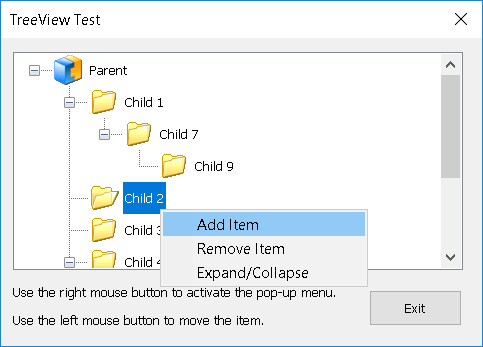Microsoft Treeview Control Version 6.0

Cannot render TreeView Web Control in IE 6.0. ASP.NET Forums on Bytes. I'd like to implement a treeview control with checkboxes in every node using Microsoft TreeView Control 6.0 in Forms 6i. I already did the following steps: 1. Download and register OCX (regsvr32 C: windows system32 comctl32.ocx) 2. Draw OCX control on form. Right click on OCX control and Insert Object 'Microsoft TreeView Control 6.0' 4. Microsoft Treeview Control, Version 6.0. Dale Fye asked on 2010-12-14. Microsoft Access; 3 Comments. Last Modified: 2012-05-10. If you have time, I'd like your opinion regarding the use of your custom code vs. The Microsoft ActiveX Treeview Control, Version 6.0 in Access 2013. I want to build a 7 level tree; however, I want to be able to include attributes and perhaps attachments. It appears to me that a customized tree is the way to go. Regards, Larry Stevens Burke, VA USA. TreeView Control (Windows Forms); 2 minutes to read; A; In this article. The Windows Forms TreeView control displays a hierarchy of nodes, like the way files and folders are displayed in the left pane of the Windows Explorer feature in Windows operating systems.
I'd like to implement a treeview control with checkboxes in every node using Microsoft TreeView Control 6.0 in Forms 6i. I already did the following steps:
1. Download and register OCX (regsvr32 C:windowssystem32comctl32.ocx)
2. Draw OCX control on form.
3. Right click on OCX control and Insert Object 'Microsoft TreeView Control 6.0'
4. Import OLE Library Interfaces 'MSComctlLib.TreeCtrl.2'
5. Set Data Block Single Record to YES
6. Set OLE Class of Listview control to 'MSComctlLib.TreeCtrl.2'
7. Rename treeview control to 'ACX_TREE' and Data Block to 'BLK_CONTROLS'
Now I need to populate the treeview adding code to the 'WHEN_NEW_FORM_INSTANCE' Trigger, but I don't see how. how to do this and/or a place where I can find a working example?
You are here:Visual Basic > Advanced VB6 tutorial > Chapter 4
Numerous properties for the TreeView control and for Node objects define the appearance of the tree and give access to nodes within the tree. You can use many of these properties to navigate through a TreeView, as follows:Child Returns a reference to the first child of a node. The Child property can be used to set a reference to a node:
Dim objNode as Node
objNode = TreeView1.Nodes(1).Child
This sets objNode equal to the first child of the node with index 1. Operations can also be performed directly on the reference to the child:
TreeView1.Nodes(1).Child.Text = 'This is the first child.'
This changes the text for the first child node of node 1.FirstSibling Returns a reference to the first sibling of the specified node. FirstSibling is a node at the same level as the specified node.
LastSibling Returns a reference to the last sibling of the specified node. LastSibling is a node at the same level as the specified node.
Parent/wondershare-filmora-scrn-serial-key.html. Returns a reference to the parent of the specified node.
Next Identifies the node immediately following the specified node in the hierarchy.
Previous Identifies the node immediately preceding the specified node in the hierarchy.
Root Provides the root node, or top-level node, in the tree for the specified node.
SelectedItem Returns a reference to the node currently selected in the TreeView control.
Nodes Returns a reference to the entire Nodes Collection for the TreeView.
You can also use the following additional properties to control the behavior and appearance of the TreeView:
Children Returns the total number of child nodes for a given node.
Selected A True or False value indicating whether a particular node is selected.
Expanded A True or False value indicating whether a particular node is expanded (that is, its child nodes are visible).
FullPath Returns a string value depicting the entire path from the root to the current node. The full path is made up of the concatenated text values of all the nodes from the root, separated by the character specified by PathSeparator property.
PathSeparator Identifies the character used as a separator in the FullPath property.
LineStyle Determines the appearance of the lines that connect nodes in a tree. LineStyle can have two values 0 (tvwTreeLines) and 1 (tvwRootLines). If LineStyle is 0, there will be lines connecting parents to children and children to each other. If LineStyle is 1, there will also be lines connecting the root nodes.
Sorted A True or False value for the TreeView. If Sorted is True, the root nodes will be sorted alphabetically by the Text property of each node. Child nodes will also be sorted alphabetically within each parent. If Sorted is False, the nodes in the TreeView will not be sorted.
When the Sorted property is set to True, the nodes that already exist in the TreeView will be sorted. If any additional nodes are added, they will not be sorted into the existing nodes.
The Sorted property will have to be set to True again for these new nodes to appear in sorted order.
Treeview Control topics
- TreeView Properties
- TreeView Events.
Microsoft Treeview Control 6.0 (sp6)
<< Previous Contents Next >>